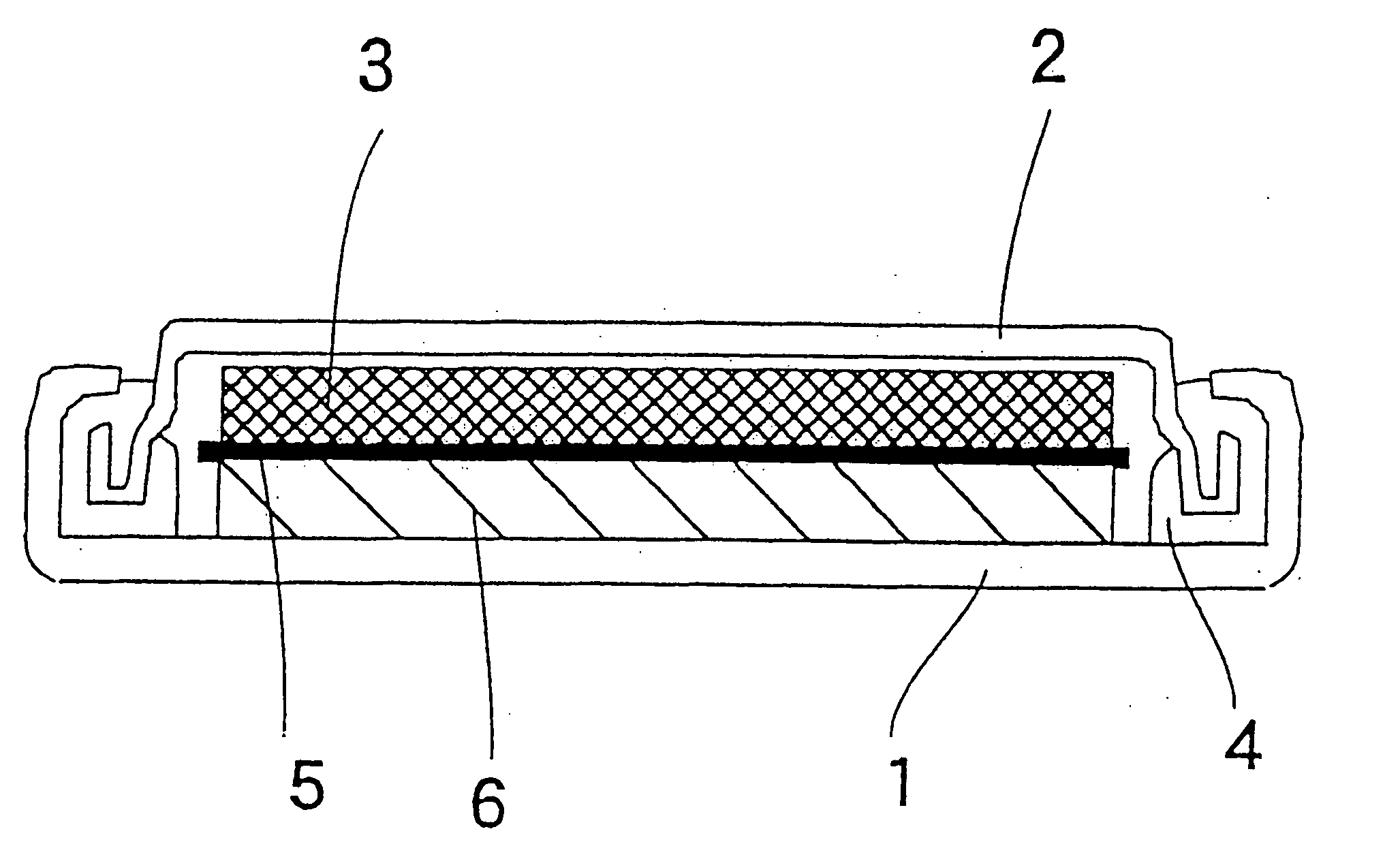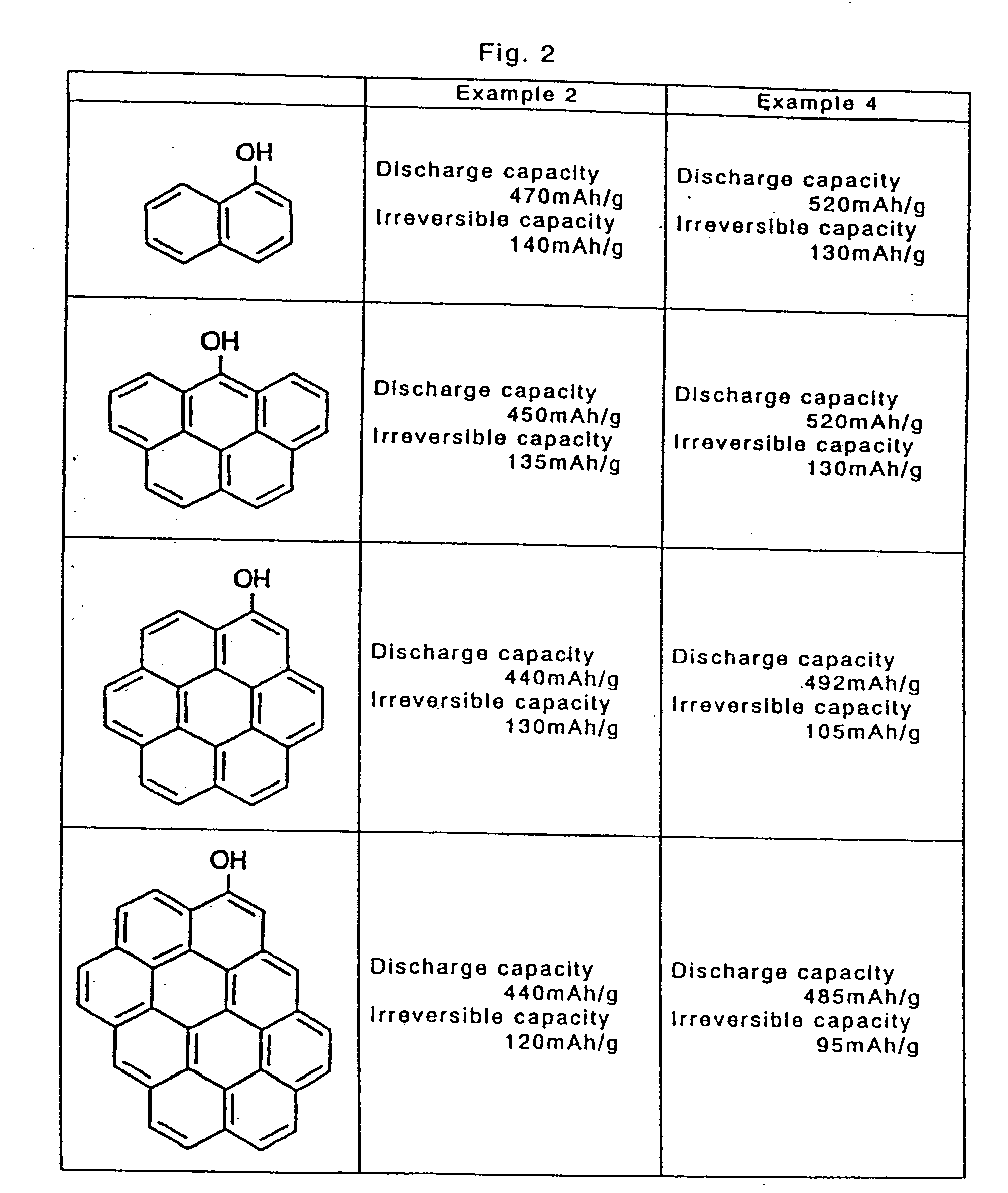Nonaqueous secondary battery, constituent elements of battery, and materials thereof
a secondary battery and non-aqueous technology, applied in the field of non-aqueous secondary batteries, constituent elements of batteries, and materials thereof, can solve the problems of overheating of batteries, large demand for secondary batteries of small size and large capacity, and the upper limit of capacity is 372 mah/g, so as to achieve high energy density, reduce the weight of batteries, and increase the effect of capacity
- Summary
- Abstract
- Description
- Claims
- Application Information
AI Technical Summary
Benefits of technology
Problems solved by technology
Method used
Image
Examples
example 1
[0131] In this embodiment, using resol type phenol resin as high polymer before curing, powder of aromatic compounds with 2 rings, 5 rings, 7 rings, 10 rings and 12 rings was added by 10 parts by weight to 100 parts by weight, and heated to 180° C. while stirring, and by holding the same temperature for 2 hours, a cured resin was obtained. Thus obtained cured resin was crushed by hammer, and was pulverized by a planetary ball mill to a mean particle size of 10 μm.
[0132] Thus obtained powder was heated in nitrogen stream at 1000° C. for 1 hours at heating rate of 5° C. / min. Mixing 3 g of obtained carbon powder into 3 g of binder having polyvinylidene fluoride dissolved in N-methyl pyrrolidone by 10 wt. %, it was applied on a copper foil of 20 μm in thickness, and dried, and an electrode plate was obtained. In an organic solvent mixing ethylene carbonate and diethyl carbonate at a ratio of 1:1, LiPF6 was dissolved by 1 mol / liter, and an electrolyte solution was prepared.
[0133] Using...
example 2
[0135] An aromatic compound shown in FIG. 2 was mixed in the resol type phenol resin at the same rate as in Example 1, and held for 10 hours at 80° C. while stirring to react with the resol type phenol resin. From thus obtained cured resin, coil cells were manufactured in the same manner as in Example 1, and the battery characteristics were evaluated. As a result, as shown in FIG. 2, by reaction after addition of aromatic compounds of 2 rings to 10 rings, sufficient practical characteristics were presented as the negative electrode of the secondary battery.
example 3
[0136] The cured resin was obtained in the same manner as in Example 1. The cured resin was first heated to 600° C. in nitrogen at heating rate of 5° C. / min, and this temperature was held for 1 hour. Once returning to room temperature, it was taken out, and pulverized by a planetary ball mill until a mean particle size of 10 μm. The time until completion of pulverization was 6 hours in Example 1, but it was 1 hour in the powder after heat treatment at 600° C.
[0137] The pulverized powder was heated again to 1000° C. in nitrogen at heating rate of 5° C. / min, and held for 1 hour. From thus obtained powder, coin cells were prepared in the same manner as in Example 1, and the charge-discharge characteristics were measured. As a result, the irreversible capacity was lowered as compared with Example 1 as shown in FIG. 1.
PUM
| Property | Measurement | Unit |
|---|---|---|
| temperature | aaaaa | aaaaa |
| thickness | aaaaa | aaaaa |
| electric conductivity | aaaaa | aaaaa |
Abstract
Description
Claims
Application Information
 Login to View More
Login to View More - R&D
- Intellectual Property
- Life Sciences
- Materials
- Tech Scout
- Unparalleled Data Quality
- Higher Quality Content
- 60% Fewer Hallucinations
Browse by: Latest US Patents, China's latest patents, Technical Efficacy Thesaurus, Application Domain, Technology Topic, Popular Technical Reports.
© 2025 PatSnap. All rights reserved.Legal|Privacy policy|Modern Slavery Act Transparency Statement|Sitemap|About US| Contact US: help@patsnap.com



